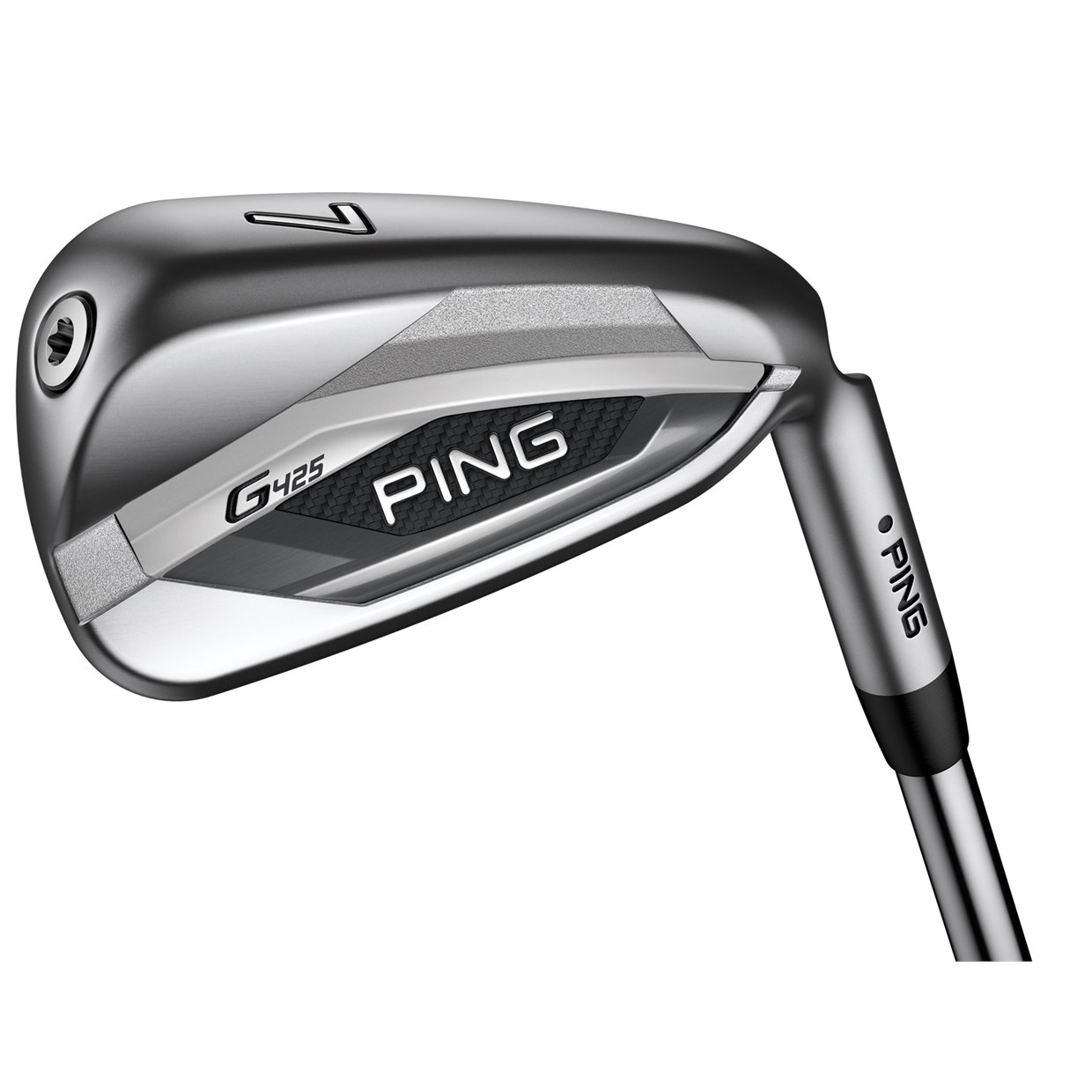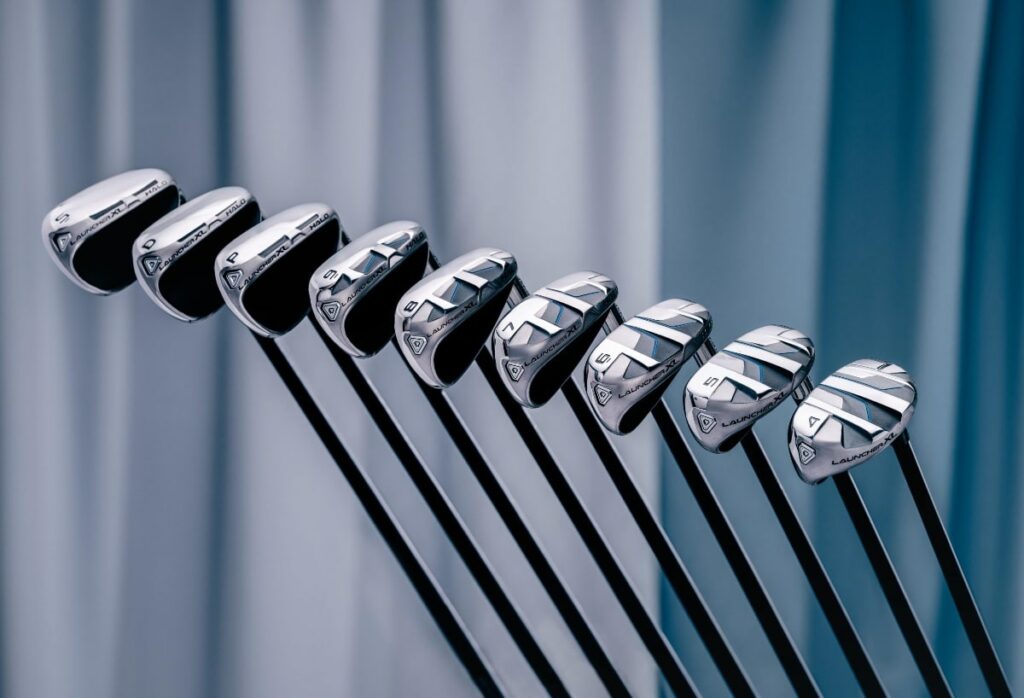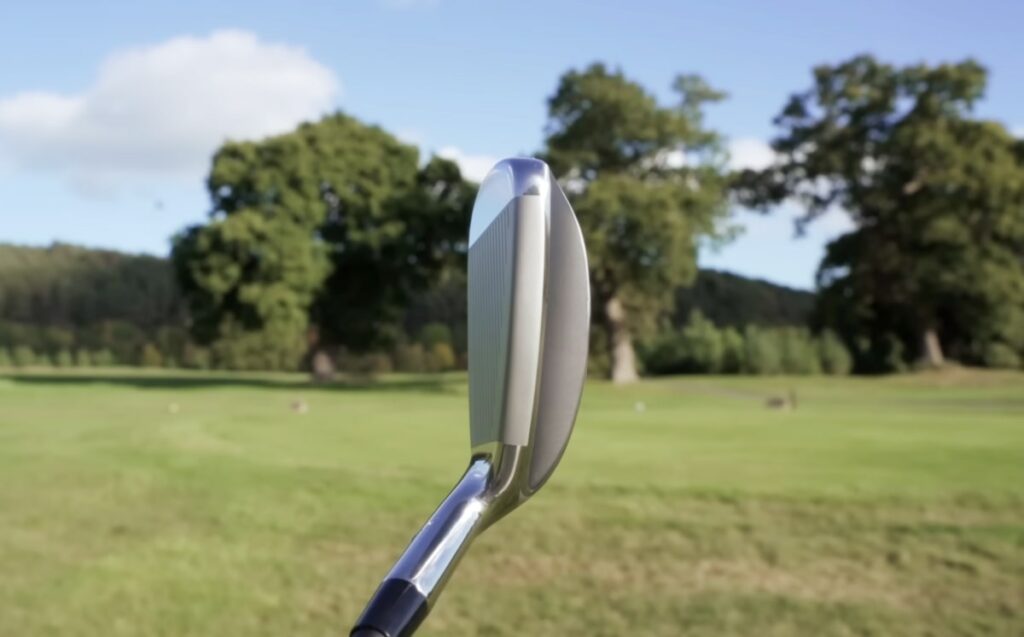Having played golf for almost 30 years, I’ve watched irons evolve drastically.
Technological advancements have made today’s irons more forgiving, easier to launch, and generally easier to hit for everyday golfers.
In this post, I address the most forgiving irons of all time to help mid, and high-handicappers find reliable tools to get from the tee box to the green.
You’ll notice that my selections are all newer irons. Ultimately, this is because golf clubs are more forgiving and easier to swing as each year passes.
Although I enjoy playing older model golf clubs, the outdated technology puts them at a disadvantage with offset, launch, and ball speed consistency.
The 5 Most Forgiving Irons of All Time
- Best Overall: Cleveland Launch XL Halo Irons
- Best for Slower Swings: Callaway Rogue ST Max OS Lite Irons
- Best for Looks: Ping G425 Irons
- Best for Distance: Cobra LTDx Irons
- Best for Slicers: TaylorMade M4 Irons
| Image | Product | Details | Price |
|---|---|---|---|
Best Overall  | Cleveland Launch XL Halo Irons |
| Check Price |
Best for Slower Swings  | Callaway Rogue ST MAX OS Lite Irons |
| Check Price |
Best for Looks  | Ping G425 Irons |
| Check Price |
Best for Distance  | Cobra LTDx Irons |
| Check Price |
Best for Slicers  | TaylorMade M4 Irons |
| Check Price |
Still undecided? If so, keep on reading to get a more in-depth breakdown of our top picks for the most forgiving irons of all time.
Cleveland Launcher XL Halo Irons
PROS
+ Promotes straighter shots
+ Helps you square the clubface
+ Encourages a high launch
+ Wide sweet spot
+ Smooth turf interaction
CONS
– Oversized
– Limits shot shaping
I found the Cleveland Launcher XL Halo irons the most forgiving overall for their accuracy, launch, distance, and affordability. The hybrid-styled irons are well suited to the slow swing speed and inconsistent ball striking of high handicap golfers.
I thought the XL heads did well to resist twisting during my swing, increasing my chances of squaring the clubface at impact. This helped me produce straighter shots and reduce the severity of my slices for greater accuracy on approach.

Cleveland engineers expertly distributed weight around the gigantic club heads to enhance the sweet spot. My ball speed didn’t drop off as significantly as it does on mishits with muscle back irons, leading to consistent distance.
Also, I welcomed the towering launch of these forgiving irons thanks to their low center of gravity. The effortless launch will suit golfers with slower swing speeds, who struggle to get the ball in the air and generate distance.
Callaway Rogue ST MAX OS Lite Irons
PROS
+ Lightweight & promotes faster club speed
+ Boosts ball speed
+ Lowers spin
+ Expanded sweet spot
+ Encourages straighter ball flight
CONS
– Not suited to fast or moderate swing speed
– The high offset restricts the workability
The Callaway Rogue ST Max OS Lite irons are a superb option for those with slower swing speeds — largely due to their lightweight components.
Lighter shafts and swing weights combine with weaker lofted clubs for an effortless launch, faster ball speed, and controlled spin.
In my experience, these irons are easier to unload at the top of the swing for maximum acceleration on the way to the ball. This helps slower swing speeds gain extra speed into impact to improve energy transfer for a powerful strike.
The High Strength 450 A.I. Designed Flash Face Cup further enhanced my ball speeds — the ball fires off the clubface. My ball launched into the air with great power and reduced spin for increased distance in the mid and long irons.
I enjoyed the effortless launch of the Rogue ST Max OS Lite and its slice-resisting flight. The offset long and mid irons promoted a lovely draw bias flight in the air.
Ping G425 Irons
PROS
+ Short blade offers an attractive look
+ Suits a wide variety of golfers
+ Combats slice side spin
+ Smooth feel
+ Easy launching irons
CONS
– Reduced workability
– Not the longest irons I’ve played, but they're consistent
In my experience, forgiving golf clubs are often chunky and unpleasant to lay eyes on. The Ping G425 irons changed this narrative by crafting a shorter blade than its predecessor, the Ping G410, for a compact, streamlined finish.
Looks aside, the Ping G425 irons pack a punch with a forgiving and explosive clubface for rapid ball speed, low spin, and excellent distance.
The tungsten toe and hosel weights do a great job of securing the perimeter of the clubface, expanding the sweet spot. My mishits were forgiven, and I experienced minimal ball pace dropoff for a solid launch and carry distance.

The stainless steel clubface conjured up exceptional speed on long and mid-iron shots across a wider area of the face to maintain my velocity on all strikes.
My speed received a further boost on low-face strikes when the thick sole stepped in to catapult the ball into the air. This is super useful if you typically hit thin iron shots. With the G425s, you can barely tell thin shots apart from flushed ones.
The feel and acoustics of the Ping G425 range surprised me for a set of game improvement irons. As with most Ping irons, I appreciated the smooth feel as the ball made contact with the face and thought the acoustics were relatively crisp.
The other benefit of Ping irons is the notch in the hosel, which allows for lie angle adjustment to fine-tune them to your personal setup.
Cobra LTDx Irons
PROS
+ Generates impressive distance
+ Flexible clubface
+ Wide sweet spot
+ Produces rapid ball speed
+ Easy irons to launch
CONS
– High launch won’t suit everyone
– Chunky sole and cavity back
The Cobra LTDx irons proved the longest forgiving iron set owing to its explosive active zone, flexible clubface, and enhanced moment of inertia (MOI).
Despite the chunky sole and cavity back design, I found the clubface to look appealing at address when set behind the ball.
After hearing the hype about Cobra‘s revolutionary PWR-COR technology, I was skeptical until it humbled me during testing. In short, it expands the sweet spot across the clubface. This forgiving zone really helped me preserve ball velocity and control my spin rate for great distances on approach shots.
Similarly, the PWRSHELL technology appeared to boost my energy transfer at contact for an explosive launch and outstanding carry and total distance.
As my testing progressed, the LTDx irons proved more than just long, forgiving irons. They also provided ample spin on short iron and wedge shots, maximizing my shot-stopping power on approach. I attribute the impressive spin levels to the premium CNC-milled grooves.
TaylorMade M4 Irons
PROS
+ High offset to resist the slice
+ Flexible clubface
+ Increased MOI
+ Less vibration on off-center hits
+ Affordable set of irons
CONS
– Slightly older golf clubs
– No 4-iron or sand wedge in the set
If you’re guilty of consistently slicing your approach shots, then the TaylorMade M4 irons (2021 version) are definitely worth a test.
These are the oldest irons on our list, and they were built to fly straighter to improve the approach game accuracy of the average golfer.
I found the M4s to have excellent forgiveness, particularly in the form of stability at impact. The large sweet spot provides good ball speeds across the clubface.
Conversely, the technology enhances the flexibility of the center of the clubface to improve energy transfer for accelerated velocity and controlled spin.

The Speed Pocket further boosts energy transfer into impact to maximize ball speed across the clubface. I feel this added acceleration is suitable for moderate and slow swing speeds who need an extra push on the downswing.
TaylorMade crafted these irons with significant offset in the long and mid irons to combat slices. This is a very useful feature to promote a draw bias.
Check out the video below by Luke Hanlon, which compares the latest version of the M4s with the superseded 2018 edition:
What Makes a Golf Club Forgiving?
The most forgiving irons of all time feature oversized club heads, high MOI, a low CG, wide soles, and an offset clubface to improve accuracy.
Below, I explain how each component contributes to the overall forgiveness.
Cavity Back
Forgiving game improvement irons feature a cavity back design.
A cavity back construction gives manufacturers more freedom to work with the geometry of the clubface. This leads to an enhanced offset, clubface flex, and perimeter weighting to improve your forgiveness.
In the video below, Mizuno’s Chris Voshall explains how a cavity back iron mold is filled with a liquid molten metal, then it’s cooled to solidify.
Perimeter Weighting
Weight around the perimeter of a golf club broadens the sweet spot and MOI.
In effect, this wider sweet spot prevents ball speed drop-off on mishits to produce satisfactory yardage on long shots — regardless of the quality of the strike.
In my experience, equally distributed mass helps the clubface resist twisting during the swing, helping me square it at contact. This results in straighter, consistent shots compared to player’s irons with minimal perimeter weighting.
Low Center of Gravity (CG)
When irons are built with low CG, it helps launch the ball in the air quicker.
To do this, golf club manufacturers position mass deep and low into the clubhead to encourage a higher launch. Visually, this will look like a thicker sole.
This works particularly well for those with slower swings, who have trouble getting the ball into the air and generating satisfactory carry distance.
It also gives the average golfer a boost on off-center strikes. This helps you launch your ball despite your mishit, once again increasing the size of the sweet spot.

Offset
Forgiving irons have a greater degree of offset than muscle backs or blades.
The degree of offset is determined by the angle of the leading edge relative to the hosel. The further back the leading edge is, the more offset the club carries.
Clubs with heavily offset clubfaces, like the TaylorMade M4 irons, are designed to promote a draw bias and minimize slice side spin. Typically, the most forgiving irons of all time will have plenty of offset to make them easier to hit.
In my case, I tend to hook more shots when using draw-bias clubs because I’ve become accustomed to squaring up my low-offset irons. When I swing draw bias clubs, the clubface is also too closed at contact.
The amount of offset an iron has also impacts its CG position. The further back the leading edge sits from the hosel, the lower and deeper the CG is. This leads to an effortless launch for mid and high-handicap golfers.
Wide Soles
The final feature of forgiving irons is their wider soles, built to improve turf interaction in the rough and on the fairway.
They’re not the prettiest-looking, but wide soles glide smoothly across the deck and work to reduce the effects of digging your club into the turf.
The idea is that if you strike behind the ball, the bounce from the sole will propel the clubface into the ball. At least you still make contact with your golf ball and produce a satisfactory shot under the circumstances.
I found the soles of the Cleveland Launcher XL Halo irons to deliver the smoothest turf interaction out of all the irons I tested.

Are New Irons More Forgiving?
Yes, new irons are more forgiving as a result of the constant technology advancements implemented in golf club production.
The first truly forgiving irons I owned were the TaylorMade R540, which were super forgiving compared to the blades and musclebacks I initially grew up with. These irons launched high and long, and the sweet spot was larger than I was used to.
Having seen the evolution of game improvement technology since the early 1990s, I am convinced new irons are more forgiving than older generations.
Final Verdict
Each year, new forgiving irons hit the shelves. It’s a big call to decide on a topic like the most forgiving irons of all time as it constantly changes with every release.
The Cleveland Launcher XL Halo irons are the best forgiving irons in the game for their easy launch, clean turf interaction, and wide sweet spot.
They meet all the criteria to offer ultimate forgiveness in an all-round package.
That said, any of the iron sets presented in this post will go a long way to improve your consistency on the course. I highly recommend you test out a few sets, then pick up the ones that are best suited to your individual swing.


